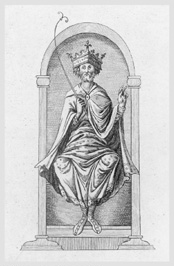The Good, the Bad and the Unready (49 page)
Read The Good, the Bad and the Unready Online
Authors: Robert Easton

On his death, an element of his rag-tag force called themselves ‘orphans’, as if they had lost their father. Michel de Montaigne writes that Zisca was with them in later engagements not only in spirit but also literally in the flesh. The reformer, it transpires, had arranged for his body to be flayed and his skin made into a drum for his men to carry into battle.
 Henry
Henry
Our English Marcellus
see
ENGLISH EPITHETS
 Edgar the
Edgar the
Outlaw
Edgar, king of England, c.1052–c.1125
Although he was proclaimed king following the death of Harold
THE LAST OF THE SAXONS
at the battle of Hastings, the teenage Edgar was never actually crowned. Instead he submitted to William the
CONQUEROR
some eight weeks later. Some chroniclers refer to him as ‘the Atheling’, meaning ‘son of the king’, but this is semantically inaccurate, since his father, ‘Edward the Exile’, was similarly never crowned.
Other chroniclers dubbed him ‘the Outlaw’ because, like his father, Edgar spent much of his life away from home, often in the Scottish court, where he married Margaret, sister of Malcolm
BIGHEAD
. In 1106 he returned from the First Crusade and was finally welcomed to England, this time by Henry
BEAUCLERC
, but only on the condition that he lived in peaceful retirement on his country estate in Hertfordshire.
 Amadeus the
Amadeus the
Pacific
Amadeus VIII, duke of Savoy, 1383–1451
Amadeus offered something of an early fifteenth-century conciliation service, giving advice and encouragement to leaders of any European powers who felt that negotiations had come to an impasse. For this international Solomonic role he was dubbed ‘the Pacific’, but it could easily have been applied to his domestic affairs. During his 42-year reign he expanded Savoy’s territory primarily through diplomatic channels rather than military force.
Surviving an assassination attempt, and unwilling to die as young as his father Amadeus the
RED
(
see
COLOURFUL CHARACTERS
), the younger Amadeus retired in 1434 to a monastery in La Ripaille. Here his religious austerity impressed his subjects so much that they dubbed him ‘the Hermit of La Ripaille’ and Rome so much that they elected him pope. After ten years, however, the quiet ways of Pope Felix V proved unpopular with the kings of France, England and Sicily, and Amadeus was pressured to resign. Peacefully he accepted the demotion to the lesser role of cardinal, and died two years later in Geneva.
 Henry the
Henry the
Parricide
Henry V, king of Germany, 1086–1125
The nickname ‘the Parricide’ does Henry an injustice since he did not kill his father. Instead, with the help of ecclesiastical and lay magnates, he merely imprisoned him and extorted from him the renunciation of his rights as ruler. The disgraced Henry IV was then allowed to escape to Liege, where he died. Lower
Rhineland peasant farmers, not caring a jot about the intrigue behind his death, trooped past his displayed corpse in order to touch it with their seed corn in the hope of a good harvest.
 Charles the
Charles the
Parson’s Emperor
Charles IV, king of Germany and Bohemia and Holy Roman Emperor, 1316–78
In his autobiography,
Mirror of Princes
, Charles relates how one day he met his old tutor Peter Roger, who had overseen his religious education while he was growing up in the court of Charles the FAIR (
see
GALLIC PRACTICE
). The teacher, now a cardinal, told his former pupil that ‘one day you will be king of the Romans’, to which Charles replied, ‘but before that you will be pope’. Both predictions came true.
With a motto of ‘Piously to see what is right’, Charles kept on good terms with popes throughout his life, a religious bond for which anti-papal elements of his court mocked him as ‘the Parson’s Emperor’ or ‘the Pope’s Errand-Boy’. However, Charles had the last laugh, his coronation as emperor of the Holy Roman Empire taking place on Easter Day 1355. Peter Roger – Pope Clement VI – had died three years earlier, but was undoubtedly there in spirit.
 Edgar the
Edgar the
Peaceable
Edgar, king of the English, c.943–75
England during the reign of Edgar was eerily quiet. The bloodthirsty ‘Erik Bloodaxe’ was dead, and the Vikings were licking their wounds back in Scandinavia. On the domestic front Edgar’s wives, including Athelfleda the
WHITE DUCK
, were producing healthy sons such as Edward the
MARTYR
and Ethelred the
UNREADY
, and the only notable violence, such as the destruction of Thanet in 969, was on the orders of the king himself. Free from the pressures of military conflict, therefore, Edgar had time for grand displays of his power. The
Anglo-Saxon Chronicle
waxes
lyrical about his sumptuous coronation ceremony at Bath in 973, and elsewhere we learn of a second carefully arranged show of royal authority that same year, when eight Celtic kings acknowledged Edgar’s over-lordship by seating him at the helm of a boat and rowing him along the River Dee. Further order and stability were brought about through reforms of the monastic and monetary systems, and it is therefore of little surprise to read chronicler John of Worcester’s description of Edgar as ‘
pacificus
’.

Edgar the
Peaceable
Some commentators, however, argue that
pacificus
should be rendered ‘the Peacemaker’ rather than ‘the Peaceable’ since the source of such national calm was not a serene monarch but the threat of military action should anyone step out of line. As the aggression against Thanet demonstrated, Edgar was always ready to remind people, brutally if necessary, who was in control.
 Edgar the
Edgar the
Peacemaker
see
Edgar the
PEACEABLE
 Edward the
Edward the
Peacemaker
see
Edward the
CARESSER